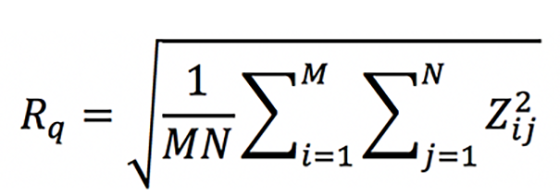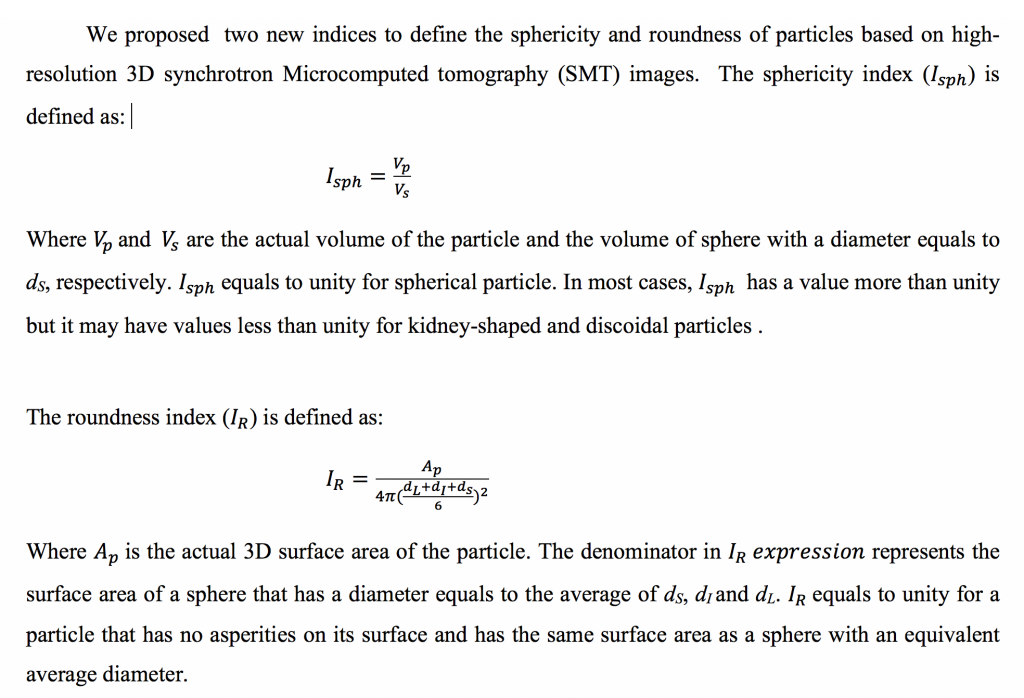Morphology, mineralogy, and gradation of particles have a significant influence on engineering properties of granular materials. Sedimentologists generally express particle morphology in terms of surface texture (roughness), roundness, and sphericity. Surface texture is used to describe the surface of particles (e.g. polished, greasy, frosted, etc.) that are too small to affect the overall shape. Roundness refers to those aspects of particle surface (sharpness of corners and edges) that are on a larger scale than those classed as surface texture, but that are smaller than the overall dimensions of the particle. Sphericity is used to describe the overall form of the particle irrespective of the sharpness of edges and corners. It is a measure of the degree of conformity of particle shape to that of a sphere.
Surface Texture
Surface texture measurements were conducted using VEECO IMOA optical surface profiler. It is a non-contact optical profiler that uses two techniques to measure a wide range of surface heights. It has two operating phase; Phase Shifting Interferometry (PSI) mode allows measuring smooth surfaces and steps, while the Vertical Scanning Interferometry (VSI) measures rough surfaces and steps up to millimeters high. Vertical scanning interferometry (VSI) measurement mode was used to collect spatial surface profile of the area. VSI is more ideal for capturing the surface profile for relatively rough surfaces (roughness greater than 100 ?m) or surfaces with discontinuities greater than 135 nm, which is a common occurrence in natural particles. The maximum vertical scan range of VSI (10 nm) was needed because the particles were relatively large and discontinuities within the field of view (FOV) were often close to or exceeded 10 ?m, especially if the FOV was located near the edge of a particle. To overcome large discontinuities within the FOV, surface profiles were taken on areas of the particle that were normal to the lens, minimizing lost data. The resolution of the system at the VSI mode is 10 nm. Scanning processing include subtracting the effect of the curvature of the particle surface.


Root mean square texture (Rq) was calculated as follows:

Where M and N are the number of pixels in X and Y direction, Zij is the surface height at a specific pixel relative to the reference mean plane.
Particle Roundness and Sphericity

ACKNOWLEDGMENTS
This material is based on work supported by the National Science Foundation under Grant No. CMMI-1266230. Any opinions, findings, and conclusions or recommendations expressed in this material are those of the authors and do not necessarily reflect the views of the National Science Foundation. The SMT images were collected using the x-ray Operations and Research Beamline Station 13-BMD at Argonne Photon Source (APS), Argonne National Laboratory. We thank Dr. Mark Rivers of APS for help in performing the SMT scans. We also acknowledge the support of GeoSoilEnviroCARS (Sector 13), which is supported by the National Science Foundation, Earth Sciences (EAR-1128799), and the US Department of Energy (DOE), Geosciences (DE-FG02-94ER14466). Use of the Advanced Photon Source, an Office of Science User Facility operated for the DOE Office of Science by Argonne National Laboratory, was supported by DOE under Contract No. DE-AC02-06CH11357.
Surface texture measurements were conducted at the Center for Nanophase Materials Sciences, which is sponsored at Oak Ridge National Laboratory by the Scientific User Facilities Division, Office of Basic Energy Sciences, U.S. Department of Energy.
Some of the Related Publications:
- Druckrey, A. M., Alshibli, K., Al-Raoush, R. (2016). “3D Characterization of Sand Particle-to-Particle Contact and Morphology”, Computers and Geotechnics, Vol. 74, pp. 26-35, DOI: sciencedirect.com/science/article/pii
- Alshibli, K., Druckrey, A. M., Al-Raoush, R., Weiskittel, T., and Lavrik, N. V. (2014). “Quantifying Morphology of Sands using 3D Imaging”, ASCE Journal of Materials in Civil Engineering, Vol. 27, No. 10, pp. DOI: ascelibrary.org/doi/abs
- Alshibli, K. A. and Alsaleh, M. (2004) “Characterizing Surface Roughness and Shape of Sands Using Digital Microscopy”, ASCE, Journal of Computing in Civil Engineering, Vol. 18, No. 1, pp. 36-45, DOI: ascelibrary.org/doi/10.1061